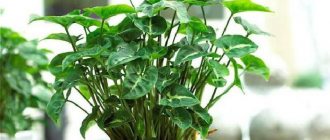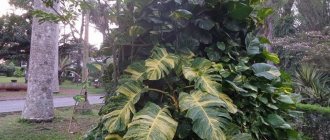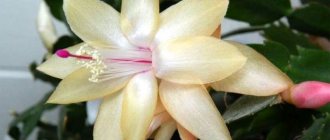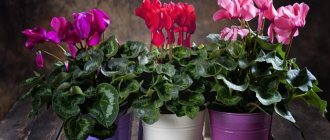Varieties of Decembrist flower
Initially, only 2 varieties of Decembrist were widespread - with white and with red flowers. The emergence of new varieties, the range of which is regularly replenished, is the merit of breeders.
The most famous varieties:
Rousseliana
A bush characterized by lush flowering and a tendency to branch, up to 30 cm high with long meter-long shoots. The petals of tubular flowers look like bells with long stamens.
Truncated
Spreading bush with light green long shoots. Multi-tiered flowers are decorated with pointed petals and a cascade of stamens. Color varies from lilac to white.
Buckley
Bush up to 40 cm high with dark green fleshy shoots. Flowers start from 8 cm in size. Color depends on the variety.
More than a hundred Decembrist hybrids have been bred. They are united in a series, the differences between which are only in the shades and sizes of the flowers. The conditions for growing Decembrist do not change.
Caring for the Decembrist at home
To grow a Decembrist flower, you need to know exactly what this exotic plant needs. On the one hand, it is unpretentious, despite its tropical origin. On the other hand, it is necessary to create favorable conditions for the plant to bloom every year.
Recommendations for growing Decembrist:
- ensure sufficiently high air humidity (by spraying);
- protect from direct sunlight, otherwise the shoots will turn red;
- do not use additional lighting, since the plant prefers short daylight hours;
- avoid waterlogging and drying out of the soil substrate;
- take it out onto the terrace in summer, place it in partial shade;
- protect the plant from drafts.
Let's talk in more detail about some of the features of growing Decembrist.
Lighting
Direct rays of the sun are pleasant for cacti. The Decembrist needs diffused light, but not a lack of lighting. A room with windows facing north is a good place to place a flower pot. He will also like the humidity of the kitchen and bathroom.
Watering
The frequency of watering depends on the stage of flower development. For irrigation, use settled water at room temperature. From October to January, when the period of budding and subsequent flowering begins, the plant needs abundant watering, but liquid should not be allowed to stagnate in the pan.
Humidity
Decembrist likes high humidity. For rapid growth and abundant flowering, regularly spray the plant or use a humidifier.
Temperature
The flower does not like temperature changes; it also does not like excessive heat and cold. The optimal temperature range is +15...+25 degrees with an air humidity of 75%. During budding, it is useful to carry out hardening on the balcony at a temperature of about +15 degrees.
Top dressing
Caring for and growing Decembrist at home cannot be imagined without regular feeding. A complex fertilizer for cacti is suitable for this purpose. Feeding is carried out according to the following scheme:
- From February to March, when the flower is resting, it is enough to just slightly moisten the soil. To prevent the soil substrate from drying out, the tray is lined with expanded clay and moss. No fertilizing is carried out during this period.
- From April until the end of summer, the Christmas tree enters the active growing season. At this time, it requires regular moderate watering. You can add ammonia to the water at the rate of 1 tsp. for 1 liter of water. Fertilizing is applied once every 2 weeks. The main components are NPK complex. The dosage of the drug intended for fertilizing home flowers is divided in half.
- In September, the plant is preparing to bloom, which means it’s time to limit watering, remembering to wet the moss in the tray to maintain optimal humidity. As soon as the buds appear, begin to intensively water and fertilize.
Transfer
Although the plant grows slowly, growing Decembrist does not exclude replanting the plant. If you buy a plant in a pot and there are roots sticking out of the drainage hole, replanting must be done immediately. If the roots are not visible, it can be postponed until the flower is 5 years old.
This is best done at the end of the flowering period. The roots of the plant are superficial and poorly developed, so a wide, shallow pot is suitable. In a container that is too spacious, the roots will actively grow to the detriment of flowering.
Transplanting an adult plant begins by filling the pot ⅓ full with drainage. The remaining ⅔ is occupied by compacted soil. The flower is moved from the old pot to the new one after thoroughly cleaning the roots from the old soil mixture. After this, all that remains is to carefully sprinkle the roots with soil and lightly water them. As the substrate settles, you can add a little more.
Trimming
Young plants do not require plucking (pruning). You can only remove buds that have bloomed. After flowering ends, the crown of adult bushes is formed. Knives are not used for this, but simply carefully remove faded, flaccid shoots and wilted buds with your hands.
Reproduction
Most often, propagation is carried out by cuttings, in rare cases by grafting onto succulents. In any case, shoots without diseases and damage are chosen for this. How to grow Decembrist from cuttings? You can immediately root them in the soil or place them in water first. In the second case, the process is accelerated.
Diseases and pests
The flower is immune to most pests and diseases, unless, of course, it is healthy. But against the background of excess or deficiency of watering, as well as in the case of proximity to diseased plants, the Decembrist’s immunity decreases.
Preparations that will help in pest control:
- spider mites - “Fitoverm”, “Vertimek”, “Aktofit”;
- mealybug - “Aktara”, “Konfidor”;
- scale insects - insecticides.
Why do the buds fall off?
Reasons why Decembrist's buds fall off:
- Improper plant care is the main reason for bud drop. From the moment the Christmas tree has been moved from the street to the room, it is not recommended to change its location or rotate it, since it is already in the process of forming buds.
- The reason for the shedding of buds can be improper watering and the plant being in a draft during the period of preparation for flowering.
Advantages and disadvantages
Decembrist is a houseplant that pleases its owner with bright blooms in winter. When purchasing a flower, which is also called Christmas tree, zygocactus and schlumberger, it is important to familiarize yourself with the care features. If you do not provide the Decembrist with conditions favorable for growth and development and proper care, there is no point in waiting for flowering.
The length of bushes with branched stems reaches 40 cm. In order for the bush to grow evenly, it should be systematically turned to the light in different directions. The main advantages of this indoor plant include:
- ease of care;
- abundant flowering;
- the possibility of reproduction by pinching off branches from 3-4 segments without flowers and placing them in a container filled with water.
The disadvantage of Christmas is considered to be susceptibility to fungal diseases such as late blight, phytium and fusarium.
Banana peel
Banana peels are rich in potassium, magnesium and phosphorus. And the powder from it is perfect for feeding the Decembrist plant before flowering.
Wash and dry fresh banana peels thoroughly. After grinding in a coffee grinder. Sprinkle the peel powder over the soil mixture and add water. This method will help your other thorny houseplants bloom lushly.
Decembrist's flaccid leaves: causes, prevention, treatment
Limp leaves on a Christmas tree indicate the death of the root system or the plant being infected by a fungal disease. As a rule, such a nuisance most often occurs against the background of fusarium, phytium and late blight. Before the disease has time to affect the root system, there is a chance to save the plant by treating it with one of the following drugs:
- "Fitosporin-M";
- "Maksim";
- "Topaz".
After processing, the Christmas tree needs to be transplanted into another container. Planting is carried out in new, uncontaminated soil.
Note! If the root system of the Decembrist is damaged, it will no longer be possible to save the flower. In this case, it is more advisable to take cuttings from the plant and grow a new one from its segments.
Decembrist leaves turn red: how to fix it
Often the foliage of a home Decembrist turns red. The reasons for changes in the color of green mass may be the following factors:
- The room lighting is too bright. Christmas tree prefers shaded areas, so flower pots should be placed on east or west windows. During the hot season, it is better to move the plants to the north side. On sunny days, flower growers advise shading the plant. If you do not follow the described recommendations for caring for the Decembrist, the foliage will begin to turn red and purple.
- Growth of new segments on foliage. In early spring, the crop begins to grow new segments. During this period, the tips acquire a reddish tint. Don't worry: the leaves will turn green again as they grow.
- Violation of the fertilizing schedule or the use of unsuitable fertilizers. In order for the Christmas tree to develop well, care should be taken to provide the plant with nutrients in a timely manner. Experienced gardeners recommend adding cacti fertilizers to the soil from October to January, which contain a significant percentage of nitrogen, phosphorus, magnesium and potassium. During the phase of active shoot growth, it is worth fertilizing the plants with mineral fertilizers in combination with organic matter.
- Often the cause of reddening of leaves is excessive watering. Decembrist does not like waterlogged soil, so the flower should be watered regularly, but not abundantly. Constantly wet soil will cause rotting of the root system. The foliage will begin to wither and turn red. To prevent the death of the crop, allow the soil to dry thoroughly. After this, you can transplant the plant into new soil, not forgetting to rinse the root system and remove the rotten part.
When should zygocactus bloom?
In nature, the Christmas cactus can bloom from October to March, depending on the rainy season. The Decembrist is actively preparing for the formation of buds after it has accumulated enough moisture that tropical showers bring.
Since such a climate is not typical for our latitudes, in the summer the plant is watered more abundantly so that when cold weather arrives it has enough strength to form flower buds.
Normally, the Decembrist blooms once a year, because preparing for the laying of future inflorescences requires a lot of resources and depletes it. However, the plant can delight the owner with fresh buds several times between November and February, if good conditions have been created for it.
How to choose a Decembrist when purchasing
When buying Decembrist in a store, you should pay attention to the appearance of the flower, as well as the quality of the soil in which it grows. The substrate should be slightly moist, and the indoor plant itself should not show signs of rot.
Despite the fact that the flowering plant looks much more beautiful, it is worth choosing a specimen, the bulk of the flowers of which are not fully revealed. The fact is that, once in home conditions, the Christmas tree sheds the bulk of its flowers. This is completely normal, so don't be upset.
It is not advisable to replant immediately after purchase. However, if the procedure cannot be postponed, you should carefully transfer the plant into a larger pot. The earthen lump cannot be disturbed in this case.
By providing proper care for the Decembrist, you can create ideal conditions for the growth and development of the plant. With its lush green foliage and vibrant, long-lasting blooms, this indoor plant will be a real addition to any room during the cold winter months.
Bone flour
Inexpensive and 100% natural, bone meal is made from ground animal bones. It serves as an excellent source of phosphorus for flowering indoor plants.
The one-time norm for one plant is 10 grams. After applying fertilizer, be sure to water your zygocactus. The nutrients in bone meal are released slowly, so once a season is sufficient.











